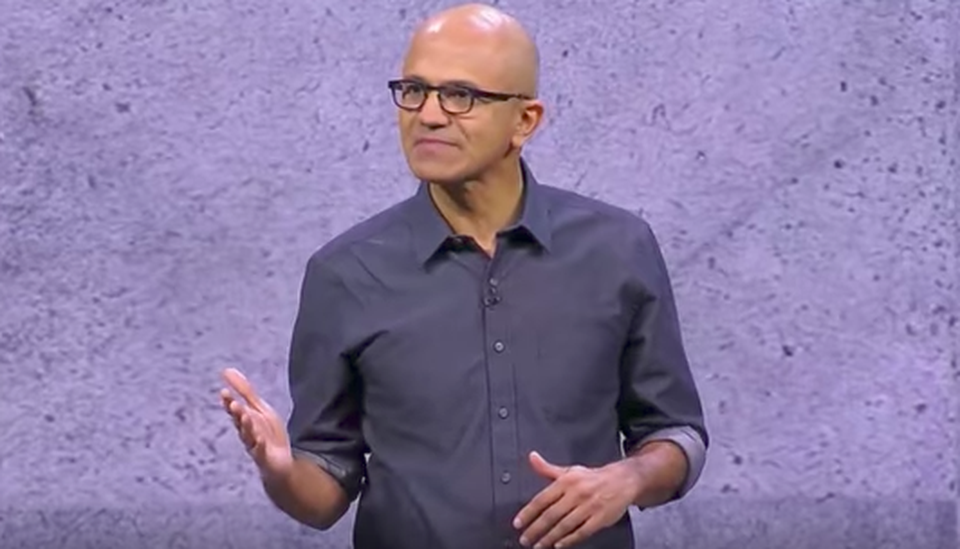
(Note: After an award-winning career in the media business covering the tech industry, Bob Evans was VP of Strategic Communications at SAP in 2011, and Chief Communications Officer at Oracle from 2012 to 2016. He now runs his own firm, Evans Strategic Communications LLC.)
CLOUD WARS — Microsoft’s booming $8.5-billion in cloud revenue last quarter has helped it open a decisive lead over Amazon as the world’s leading enterprise cloud provider for the past 12 months, $26.7 billion to $23.4$ billion.
While Amazon’s AWS cloud unit put up another set of great numbers for the quarter ended Sept. 30—$6.68 billion in revenue, up 46%—Microsoft’s fiscal first quarter was simply better and reflected its continued strength across every facet of the white-hot enterprise-cloud market, with commercial-cloud revenue at 47%.
Some highlights for the 3 months ended Sept. 30:
- Azure revenue up 76%;
- Dynamics 365 up 51% in the SaaS layer;
- Dynamics 365 revenue expected to hit $1.25 billion for the fiscal year (ending June 30, 2019); and
- LinkedIn revenue up 33% to about $1.5 billion.
During his prepared remarks on Microsoft’s earnings call last week, CEO Satya Nadella offered this perspective on the centerpiece of the Microsoft cloud: “Azure is the only hyperscale cloud that extends to the edge across identity, data, application platform and security and management. We introduced 100 new Azure capabilities this quarter alone, focused on both existing workloads like security and new workloads like IoT and Edge AI.”
For AWS, some analysts and media outlets made a big to-do about the fact that the rate of growth for Amazon’s cloud business took a tiny downward turn for the quarter, slipping from 49% to 46%.
I think that’s an overblown detail—if you look at the last several quarters, AWS has consistently achieved the remarkable feat of having its growth rate increase even as it has approached an annualized run rate of $25 billion. Starting with Q4 of 2016, the revenue-growth rate for AWS has been 42%, 42%, 44%, 48%, 49% and most recently 46%.
The very same minor decline in rate of growth occurred at Microsoft as well—its commercial-cloud revenue for the period ending June 30 was 53%, and then for the 3 months ending Sept. 30, that slipped to 47%.
It’s pretty much inevitable that as the cloud businesses of Microsoft and Amazon reach this type of scale–$26.7 billion in revenue for the past 12 months for Microsoft, and $23.4 billion for Amazon—growth rates will eventually decline. But if somebody’s got a problem with 47% growth for $25-billion businesses, then I’d say that person doesn’t have a clue.
For IBM, its cloud business was one of the few bright spots in a largely challenging quarter as it posted $19 billion in cloud revenue for the 12 months ending Sept. 30, with the “as a service” portion of the IBM Cloud racking up $11.4 billion in revenue, up 24%.
But yesterday, IBM took a huge step to scale its cloud business by agreeing to acquire Red Hat for $34 billion, an acquisition that would add about $3 billion to IBM’s annual cloud revenue.
For Microsoft and Amazon, the competition over the next year will center on more than advanced cloud and AI technology as Microsoft continues to hammer on Amazon’s aggressive corporate strategy of jumping into an expanding array of industries and pitting itself as a direct competitor of businesses that might otherwise be viable prospects for AWS.
*******************
RECOMMENDED READING FROM CLOUD WARS:
The World’s Top 5 Cloud-Computing Suppliers: #1 Microsoft, #2 Amazon, #3 Salesforce, #4 SAP, #5 IBM
Amazon Versus Oracle: The Battle for Cloud Database Leadership
As Amazon Battles with Retailers, Microsoft Leads Them into the Cloud
Why Microsoft Is #1 in the Cloud: 10 Key Insights
SAP’s Stunning Transformation: Qualtrics Already “Crown Jewel of Company”
Watch Out, Microsoft and Amazon: Google Cloud CEO Thomas Kurian Plans To Be #1
The Coming Hybrid Wave: Where Do Microsoft, IBM and Amazon Stand? (Part 1 of 2)
Oracle, SAP and Workday Driving Red-Hot Cloud ERP Growth Into 2019
*********************
As Nadella said in his opening remarks on the earnings call, “Our cloud platforms and tools enable our customers to build tech intensity while ensuring we are addressing their tough questions around trust – both trust in technology and trust that they have a partner whose business model is aligned to their success. No customer wants to be dependent on a provider that sells them technology on one end and competes with them on the other.”
I’ve analyzed and written about the enterprise-tech business for more than 20 years from the media side as an editor-in-chief and chief content officer, and more recently as Chief Communications Officer at Oracle from 2012-2016. I’ve written thousands of articles and columns… MORE
As businesses jump to the cloud to accelerate innovation and engage more intimately with customers, my Cloud Wars series analyze the major cloud vendors from the perspective of business customers.








